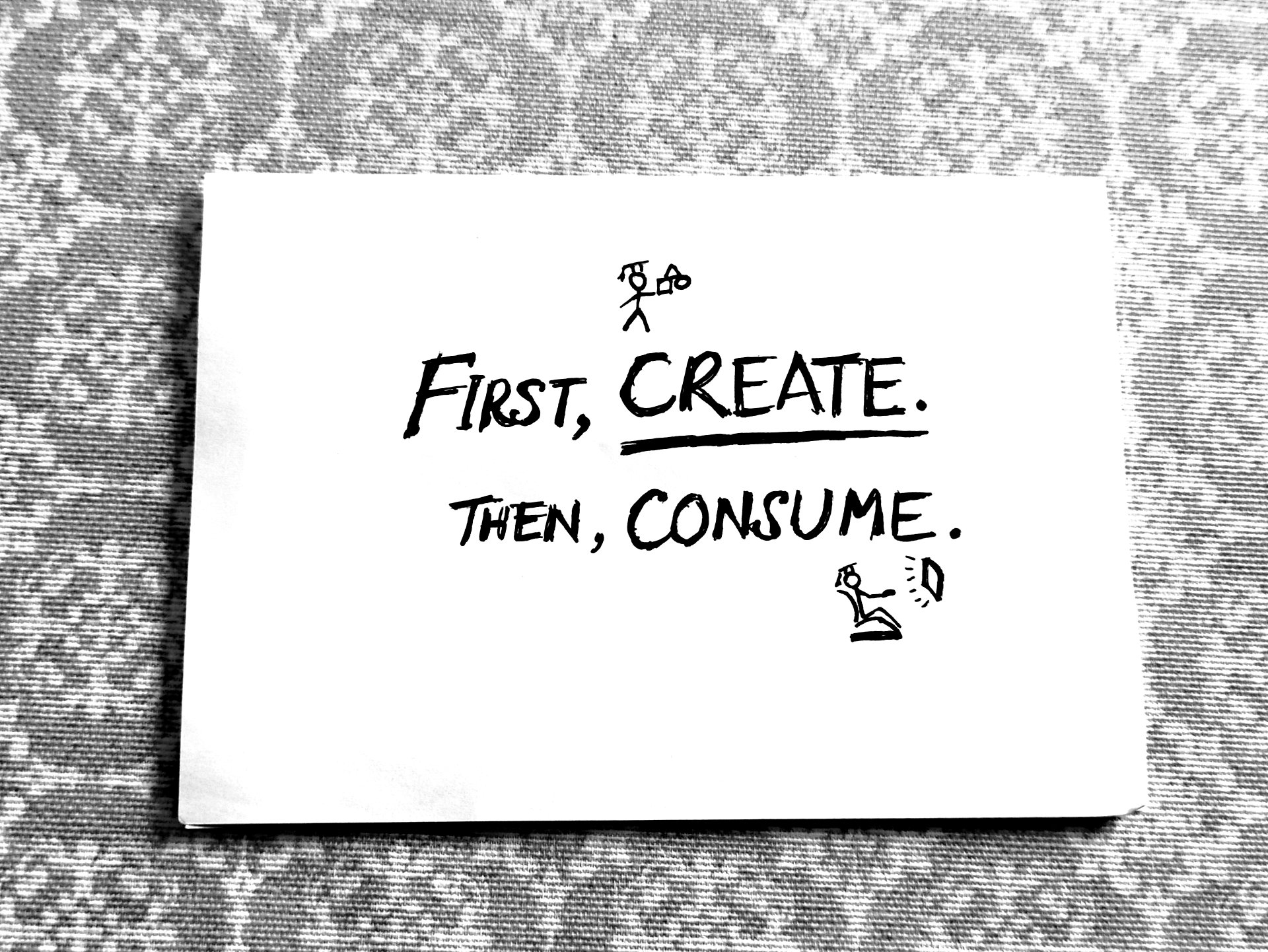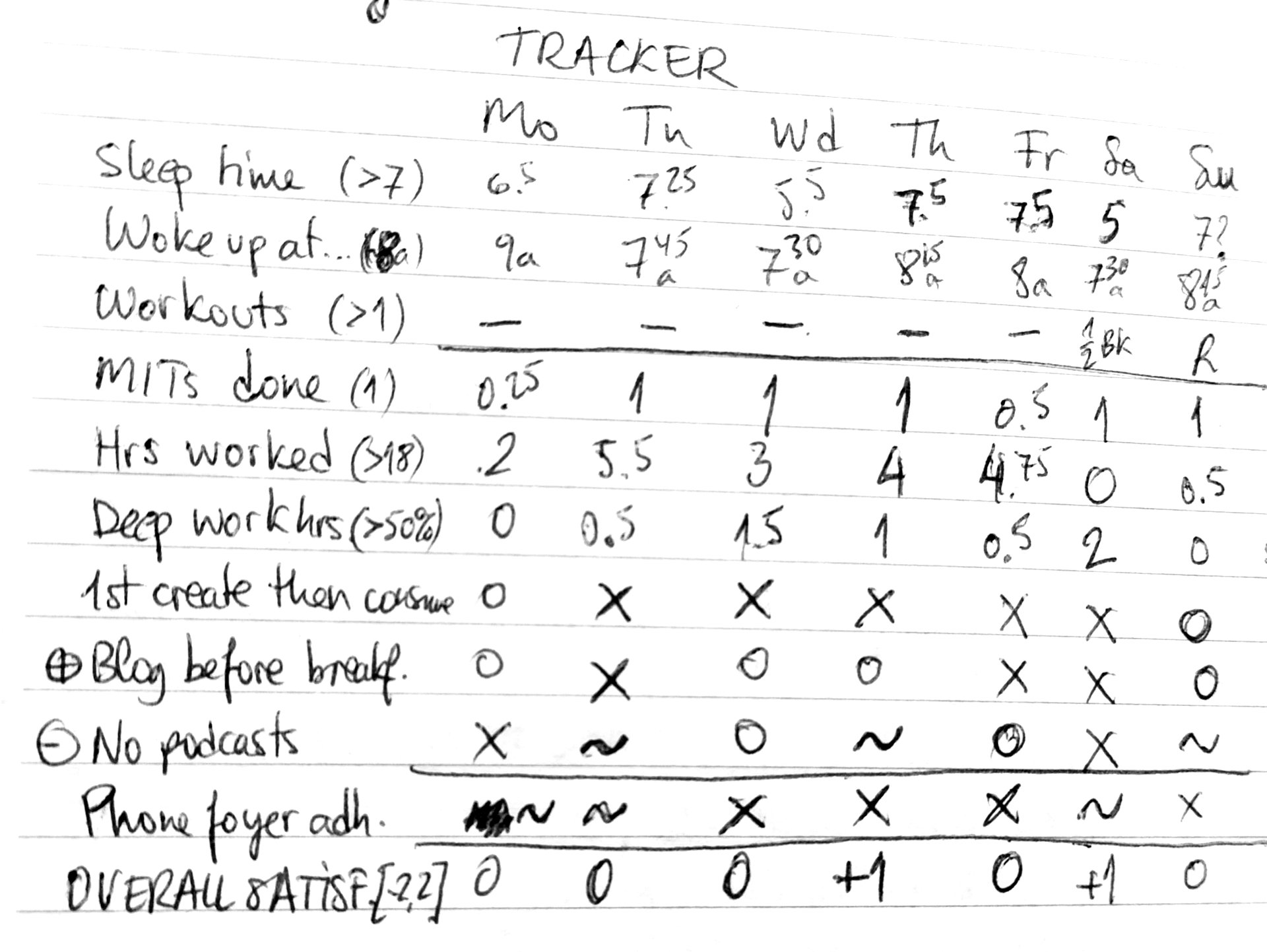POSTS
The Create/Consume Hypothesis: A simple rule for more effective and valuable PhD work
by Luis P. Prieto, - 9 minutes read - 1896 wordsDo you start your workday full of energy and eager to tackle your research but find yourself by mid-morning already spent and demoralized? Does this happen after a flurry of email interactions, social media scrolling, or passive meetings? You may be experiencing the differential effects of creative and consumptive work on your motivation and energy. This post will go over a (still half-baked) idea about how different kinds of work energize us, and simple rules that we can implement for a more sustained sense of progress and satisfaction with our (PhD or otherwise) work.
I walk drowsily out of my bedroom. It’s 7AM. The sun is not visible yet, but I can already hear the birds chirping in the urban square outside. I grab a glass of water from the kitchen and go to the armchair in the corner of the living room that will receive the first rays of sun. I open the laptop, and the half-written draft of the blog post appears onscreen. I read the last paragraph, and start typing away, the faint clacking filling the hallway of the otherwise silent apartment. With a bit of luck, 45 minutes will pass until the next person wakes up.
Today’s gonna be a good day.
The Create/Consume Hypothesis
The small vignette above exemplifies a typical start of a satisfying day. As I experiment with different working configurations (e.g., activity ordering, choice of place, etc.) and journal about the results, a conjecture has been taking shape, about a key differential factor separating good days from not-so-good days:
Hypothesis: Doing focused, creative work on something important to us before we engage in reactive work or media consumption, leads to higher productivity, progress and better mood than the opposite.
On the face of it, this hypothesis may seem strange – why would the order in which we do things matter? And, don’t we need to consume ideas before we can produce our own? Yet, this hypothesis resonates with several research works and productivity practices I’ve encountered over the years.
A good part of the hypothesis is similar to what productivity author (and computer science professor) Cal Newport posits in his book Deep Work1: that the most valuable knowledge work often comes from focused, cognitively demanding efforts (what he calls “deep work”); and that these efforts actually feel inherently satisfying. The main difference here is my emphasis on the sequence order. This reminds of an age-old piece of advice known as “granny’s rule” (you have to eat your vegetables before you eat sweets for dessert). Doing the most important (and often, difficult) thing first ensures that it will be done – which is obvious advice, but we often avoid with a variety of excuses. The creative types among you may also find this hypothesis similar to Julia Cameron’s idea of “morning pages”2: doing about three pages of longhand writing when we wake up, as a way to exercise our creative muscles. This is not unlike what many early morning exercisers report: that doing some vigorous exercise in the early morning (even before they have breakfast), helps them set the mood and intentionality for the rest of the day. I certainly felt this small but tangible sense of accomplishment during a research stay in Twente (The Netherlands), after biking 13km to the office in the mornings (regardless of the –often rainy– weather).
Several mechanisms may explain the sense of accomplishment that I get after doing a noticeable chunk of creative work in the mornings, before I engage with email or the world news. For instance, Teresa Amabile’s research on the “progress loop”3 that effective knowledge workers experience (i.e., progress fostering good mood, which itself fosters more creativity and progress). It could also be that starting out with reactive work (or consuming media) crowds out our mental space and attention with other people’s (probably less relevant to us) worries and ideas – even after we finally switch to doing the creative work that is most important to us (as supported by Sophie Leroy’s studies on “attention residue”4). But maybe my favorite mechanism for why this rule works is Schwartz’s theory of basic values5, which states that some people value autonomy (to learn and do creative things, in one’s own way) over almost everything else – a population I have observed overlaps strongly with PhD students and researchers. Ryan and Deci’s self-determination theory6 makes autonomy one of the three key basic human needs, hinting that this could be an even more universal phenomenon. Be it a value or a need, acting on it and achieving something is bound to feel motivating and satisfying.
Creating and consuming in the PhD: Metrics and Mantras
But what does “creative work” mean in the context of doing a PhD or, generally, research? Most of us are scientists, not poets! I’d like to argue here that most research activities are creative. They basically entail making something new that did not exist before (in the most basic sense, we are creators of new knowledge). Let’s look at typical activities a researcher does, and whether they imply creating something (proactively) or consuming (or reacting to) something:
- Designing a new experiment – Creating/Proactive
- Reading and answering emails – Mostly Consuming/Reactive (we tend to spend more time reading others’ emails and reacting to them than creating entirely new initiatives)
- Exploring or analyzing a dataset – Creating/Proactive
- Developing a prototype or instrument – Creating/Proactive
- Synthesizing results or literature into a new theory or conceptual framework – Creating/Proactive
- Writing a paper trying to convey the results of our latest study in a concise format – Creating/Proactive
- Teaching courses to students – Mostly Creating/Proactive
- Reading a lot of research in our area – Consuming/Reactive (but synthesizing/summarizing them and what they imply for our own research – a critical part of reading research – is Creating/Proactive work)
- …
Looking at the list above, we can also get the intuition that the “creative” research activities are also the most valuable. The implications of this hypothesis, if true, are clear: we should be doing these creative research activities early and often (ideally, every day). We could summarize this into a short “monday mantra” that we could put somewhere visible when we wake up and/or our workspace:
This mantra should be enough to remind us to focus on the important, creative research tasks (maybe, our Most Important Task (MIT) of the day; ideally, something related with one of our main dissertation milestones)… However, many of us have brains that are sneaky little procrastination machines, and will find ways to avoid what we know is the hard but important creative task at hand by coming up with all sorts of excuses. In those cases, we can make our own variant of the mantra above, by pasting the concrete creative task that we know is most important, and our favorite morning procrastination activity: “Write for my paper before checking Facebook”; “First, work on the design of my next study, then read email”; etc.
Also, as you know, I am a big fan of self-tracking important metrics every day, to keep my behavior aligned with my mid- and long-term goals. This little mantra (or the concrete variation of our choice) is a nice candidate for something to track, if we find that this hypothesis works for us. Here’s a sample of a recent weekly tracker of mine:
Don’t let the opening vignette fool you into thinking that executing this simple rule is easy, or that your experience will always be great. Indeed, I’m currently struggling with implementing it, due to a 7-month old baby with random waking habits (still trying to make it work!). Yet, my experience is that, when I manage to do it consistently, my average experience is better. Indeed, once you get good at this rule, you could create additional instances throughout the day (e.g., start your afternoon work also with creative work, before doing email or media consumption).
Bonus tip: Make sure you have the “creative materials” (e.g., your manuscript file or the half-baked design of your next study) ready when you sit to work, to minimize friction and potential distractions. Use every precious minute of this creative stretch! For instance, I use MS Windows’ multiple desktop function to have a virtual space with my latest blog draft open in full-screen mode, ready for my next “create before consume” stretch.
(Update 13.06.2022) A Caveat: One common pitfall of this strategy (it has happened to me a few times since I formulated the hypothesis) is that, once we fail to do a focused, creative activity first in a day, we may throw our hands in the air and leave the creative task altogether until the next day. This is typically the resistance in our brains making up reasons to continue procrastinating and avoiding a hard uncertain task (a very energy-conscious organ, the brain). Don’t fall for this excuse! A suboptimal day in which we consumed/reacted first but eventually created something of value will be way better than one in which we didn’t create it at all!
It’s not only about work: Creative leisure
This is more of a corollary of the hypothesis: this create/consume dichotomy may also work for leisure activities. If I look back, I think I was more satisfied when I was doing a lot of concentration-filled, flow-inducing, creative leisure (e.g., observing my surroundings and practicing photography; writing a children’s tale for my niece; brainstorming cool ideas for a friend’s birthday present; planning my next holiday) rather than reactive, passive media consumption and similar leisure activities (e.g., scrolling on social media; watching series episodes back-to-back). Don’t get me wrong, I still love reading books or watching a good movie. Simply, I find that exerting my creative muscles first seems to work better, even in leisure.
I hear a faint moan from the other side of the apartment. The little one must be up and about. I finish typing the sentence I was midway through and close the laptop. I realize with a vague sense of satisfaction that another section is almost done. Now the moan is a full-blown scream. I sigh and walk through the hallway to the bedroom, an imperceptible spring in my stride, and hoping the neighbors were already awake. “I’m comiiiiiing!"
Have a good, creative day!
Have you tried the create/consume rule described in this post? Did it work for you? Do you also have other rules that you implement to improve your mood and productivity? Share them with us in the comments section below!
Header image by Gene Wilburn.
-
Newport, C. (2016). Deep work: Rules for focused success in a distracted world. Hachette UK. ↩︎
-
Cameron, J. (2020). The artist’s way. Lev. ↩︎
-
Amabile, T., & Kramer, S. (2011). The progress principle: Using small wins to ignite joy, engagement, and creativity at work. Harvard Business Press. ↩︎
-
Leroy, S. (2009). Why is it so hard to do my work? The challenge of attention residue when switching between work tasks. Organizational Behavior and Human Decision Processes, 109(2), 168–181. ↩︎
-
Schwartz, S. H. (2012). An Overview of the Schwartz Theory of Basic Values. Online Readings in Psychology and Culture, 2(1). https://doi.org/10.9707/2307-0919.1116 ↩︎
-
Ryan, R. M., & Deci, E. L. (2000). Self-determination theory and the facilitation of intrinsic motivation, social development, and well-being. American Psychologist, 55(1), 68–78. ↩︎

Luis P. Prieto
Luis P. is a Ramón y Cajal research fellow at the University of Valladolid (Spain), investigating learning technologies, especially learning analytics. He is also an avid learner about doctoral education and supervision, and he's the main author at the A Happy PhD blog.

